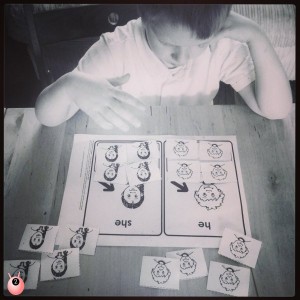 The Sensory Seeker was struggling to understand the difference between the personal pronouns he and she. He knew that boys and girls are different but calls them both “he.” The Sensory Seeker does not really understand how people could get upset by being called the wrong thing but guess there’s only so many times a girl wants to be called a boy.
The Sensory Seeker was struggling to understand the difference between the personal pronouns he and she. He knew that boys and girls are different but calls them both “he.” The Sensory Seeker does not really understand how people could get upset by being called the wrong thing but guess there’s only so many times a girl wants to be called a boy.
Based on the work by Felicity Durham the personal pronouns activity we did was simple, and great for the visual learner. It simply consisted on the child having a piece of paper divided into two. On one side there was a picture of a boy and the word he and a big empty box underneath, and the other side the same but with a girl and the word she. The same images were then repeated on another piece of paper but smaller (so that there were a total of 16 small image, 8 boys and 8 girls).
First we discussed the pictures by me asking which was a boy and which was a girl. I started with this because I knew he would know the answer. This helped him feel more confident which means it is easier to engage and hold his attention. Next I saw whether he recognised the words “he” and “she,” by sight. He didn’t and sounding them out was difficult as they are not phonetically sounding and so he was reading the ee as eh. I helped him understand and waited until I could hear that he knew and could say them both. Next I took my pile of small images and showed him that they were the same as the large ones. I mixed up the pile and got him to guess which card I would turn over, explaining that he needed to give me the answer “he” or “she.” He got really excited when he got it right and said that it was a point! Even when he did not correctly guess he was beginning to really say “she” (as he had previously only said he). I was firm in that I would not allow him to just point or refer to them as boy and girl. As there were only 16 images it was over quickly and so just right for his attention span.

Great round-up as always.
Great round-up with some fab ideas. Syd is all about counting at the moment, so I think he would love the rainy day game!
I had no idea that a child might have trouble with he and she. thank you so much for educating me about these things. Whilst I don’t have a child with these issues i think it is really important that I understand they exist. So a big thank you for this round up.
I am realising how many concepts which are seem simple to adults, children can miss. Games can make such a difference can’t they. Lovely picture.
Fantastic activity to help further a child’s understanding of ‘he’ and ‘she’. It is always worth remembering that children aren’t born with an understanding of any of these things. Everything is learnt, by watching, listening and questioning and everyone learns differently x
Great round up – lots of posts that I’ve pinned to come back to later. And fascinating about the he/she issue. Something that my (nearly) 4 year old does sometimes so I’ll also be pinning that to come back to. Thanks Joy!
Gosh so many wonderful ideas there Joy, I see round-ups like this and realise I need to be more inventive. Mich x
Oh wow ! tons of fab ideas Joy
Flippin ‘eck Joy! 124 linkups already! There are so many brilliant ideas here, what a great resource xx
So many great ideas. Why didn’t I know you were doing this before? Amy is obsessed with shapes at the moment, naming them, finding shapes within shapes. It’s quite interesting to watch x
Thank you so much for featuring out ABC wood slices!
Such good ideas here and linked up too – prefect half term fodder!
Thank you for sharing Joy! This really helps!
These are great – I love the Lego letters especially!
My youngest calls everyone ‘he’ (but knows that women have ‘boobies’ and men and boys have ‘willies’)! We will have to play your game 🙂